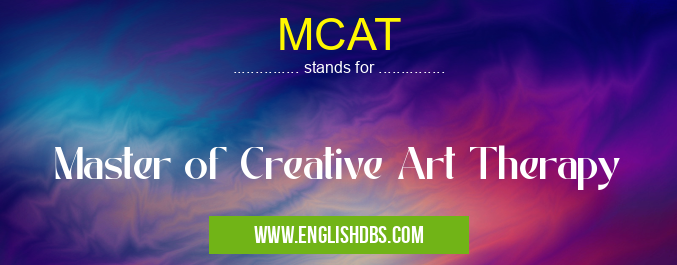What does MCAT mean in THERAPY
MCAT stands for Master of Creative Art Therapy. It is a postgraduate degree that qualifies individuals to practice creative art therapy, a form of psychotherapy that uses artistic expression to promote mental, emotional, and physical well-being.

MCAT meaning in Therapy in Medical
MCAT mostly used in an acronym Therapy in Category Medical that means Master of Creative Art Therapy
Shorthand: MCAT,
Full Form: Master of Creative Art Therapy
For more information of "Master of Creative Art Therapy", see the section below.
What is Creative Art Therapy?
Creative art therapy is a therapeutic approach that utilizes various art forms, such as painting, drawing, sculpting, music, and dance, to facilitate healing and personal growth. It is based on the belief that artistic expression can provide a safe and non-verbal means of communicating emotions, exploring inner conflicts, and fostering self-awareness.
Benefits of MCAT
Pursuing an MCAT degree offers numerous benefits, including:
- Enhanced Clinical Skills: Graduates develop advanced clinical skills in assessing, diagnosing, and treating mental health conditions.
- Specialized Knowledge: MCAT programs provide in-depth knowledge and training in creative art therapy techniques, theories, and research.
- Professional Recognition: MCAT holders are recognized as qualified professionals within the field of art therapy.
- Career Opportunities: Graduates can pursue careers in various settings, such as hospitals, mental health clinics, schools, and private practice.
Essential Questions and Answers on Master of Creative Art Therapy in "MEDICAL»THERAPY"
What is Master of Creative Art Therapy (MCAT)?
MCAT is a graduate-level degree that prepares individuals to become creative art therapists. It combines coursework in art therapy, psychology, and counseling theory to provide students with the knowledge and skills necessary to work with individuals and groups using creative art expression.
What are the career prospects for MCAT graduates?
MCAT graduates can work in a variety of settings, including hospitals, clinics, schools, and community centers. They may work with individuals who are experiencing mental health issues, trauma, or physical disabilities. They may also work with groups to promote well-being and creativity.
What are the admission requirements for MCAT programs?
Admission requirements for MCAT programs vary, but typically include a bachelor's degree in art therapy or a related field, a portfolio of creative work, and letters of recommendation. Some programs also require an interview.
What is the duration of an MCAT program?
MCAT programs typically take two to three years to complete. Some programs offer part-time options, which may extend the duration of the program.
What is the difference between an MCAT and an MA in Art Therapy?
An MCAT is a graduate-level degree that focuses specifically on creative art therapy, while an MA in Art Therapy is a more general degree that may include coursework in other areas of art therapy, such as art education or art history.
Final Words: The MCAT degree is a valuable qualification for individuals seeking to become certified creative art therapists. It provides comprehensive training, advanced clinical skills, and professional recognition. By combining the transformative power of art with therapeutic principles, MCAT graduates are equipped to make a meaningful impact on the well-being of individuals and communities.
